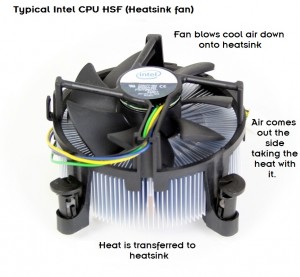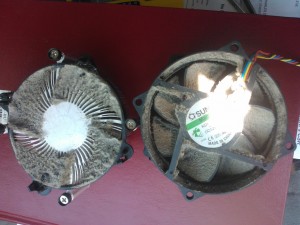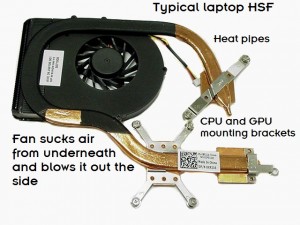I gave an education talk the other day about the importance of maintaining your PC or laptop and how dust and dirt can seriously cause major problems if not rectified.
First things first, if you don’t have the confidence to do the job yourself, you could make the problem worse and damage your computer (or yourself). Use an anti-static strap to avoid static discharge. If you are not confident, please consult the professionals.
CPU’s (Central Processing Units) are the main brain of a computer and they can produce a lot of heat. To dissipate that heat, a heat sink and fan are required to keep the CPU running cool. There are other ways of keeping the CPU cool (water cooling, etc), but I won’t go into those methods.
Desktops – There are many varieties of heatsink fan (or HSF’s) available but for the purpose of this blog entry, I’ll talk about the most common type. They work by having a fan blow air onto the heatsink and through the fins out the side of the heatsink to get dissipate the heat. This process works extremely well as a way of reducing the heat the CPU produces.
The biggest problem is that over time, dust, dirt, hair and other particles that get carried around in the air get blown onto the heatsink and eventually cause a blockage, a mat of dust in actual fact. When this happens, the fan is blowing air, but due to the dust covering the heatsink, the air has nowhere to go and everything overheats.
Laptops – HSF’s for laptops work in a similar manner, but due to space constraints, the design is different but fundamentally they work the same. They vary in shape and size, depending on the laptop specifications and are usually designed to remove heat from the graphics processing unit as well as the CPU. Heat pipes are often used (copper tubes) to transfer the heat to the fins so it can be easily dissipated. Air gets sucked in from underneath, which then passes through the fins and blown out the side of the laptop.
Same problems can occur as with the desktop configuration. Dust can cause blockages which leads to overheating. Major difference however is that getting access to the fan in a laptop requires a lot more work. More than likely, complete disassembly is required. This is not recommended unless you know what you are doing.
Typically, most of us don’t check our computers every day for dust build up, but a clean out every six to twelve months (depending on environment) is a good way to keep your system running smoothly.
When the problem gets really bad, there are a number of warning signs to let you know something is wrong.
• The fan speed increases to very loud levels. When the CPU is not adequately cooled, the system board senses this and makes the fan spin faster to try and compensate and cool the CPU.
• The computer or laptop is hotter to the touch. Sometimes so hot it can actually do damage to surrounding components. Heat is not good.
• The system runs very slowly. Some CPU’s when hot, shut down areas within the processor in an attempt to reduce the heat. The CPU is not running at it’s full potential which causes the slowness.
• Worst case scenario, the CPU gets so hot it shuts itself down to prevent damage to itself. An audible beeping from the mainboard is usually heard and the computer turns off.
I have heard of fires starting due to overheating computers, so it’s very important that it’s maintained and kept running as cool as possible. As an added bonus, having a clean computer will also increase the life span of the hardware and it will last you much longer.
Cleaning – As always, prevention is better than cure. For desktops, one way to prevent a constant build up of dust and dirt is to have dust filters installed on all the intake case fans so the air that is within the case is always clean. Location of the PC is also important. Up off the ground and away from carpet and other sources of dust are also recommended.
For laptops, using the device on a clean hard surface is recommended to keep them as clean as possible. Due to the way laptops are designed (suck air in from underneath), it is not recommended to use them on carpet, in the bed or on any other like surface.
I don’t recommend using a vacuum cleaner as it can cause static damage to the electronic components. Manual cleaning with a brush is the only truly safe way to effectively remove all the dirt build up. For desktop computers, it’s usually just a simple matter of removing the side of the case and you have easy access to the heatsink and fan. Laptops however usually involve complete disassembly and require more time and technical know how.
If you think your computer is not running as well as it used to or it sounds like a jet aircraft, please contact us before the worst happens. Our number is 0447 619 397 or you can send us an enquiry, either through our contact page, by Facebook or by email, helpme@ckpcomputers.com.au.



